An application of neural networks to adaptive playout delay in VoIP
The statistical nature of data traffic and the dynamic routing techniques employed in IP networks results in a varying network delay (jitter) experienced by the individual IP packets which form a VoIP flow. As a result voice packets generated at successive and periodic intervals at a source will typically be buffered at the receiver prior to playback in order to smooth out the jitter. However, the additional delay introduced by the playout buffer degrades the quality of service. Thus, the ability to forecast the jitter is an integral part of selecting an appropriate buffer size. This paper compares several neural network based models for adaptive playout buffer selection and in particular a novel combined wavelet transform/neural network approach is proposed. The effectiveness of these algorithms is evaluated using recorded VoIP traces by comparing the buffering delay and the packet loss ratios for each technique. In addition, an output speech signal is reconstructed based on the packet loss information for each algorithm and the perceptual quality of the speech is then estimated using the PESQ MOS algorithm. Simulation results indicate that proposed Haar-Wavelets-Packet MLP and Statistical-Model MLP adaptive scheduling schemes offer superior performance.
HIERARCHICAL MOTION ESTIMATION FOR EMBEDDED OBJECT TRACKING
This paper presents an algorithm developed to provide automatic motion detection and object tracking embedded within intelligent CCTV systems. The algorithm development focuses on techniques which provide an efficient embedded systems implementation with the ability to target both FPGA and DSP devices. During algorithm development constraints on hardware implementation have been fully considered resulting in an algorithm which, when targeted at current FPGA devices, will take full advantage of the DSP resource commonly provided in such devices. The hierarchical structure of the proposed algorithm provides the system with a multi-level motion estimation process allowing low resolution estimation for motion detection and further higher resolution stages for motion estimation. An initial MATLAB prototype has demonstrated this algorithm capable of object motion estimation while compensating for camera motion, allowing a moving object to be tracked by a moving camera.
An FPGA Implementation of Hierarchical Motion Estimation for Embedded Oject Tracking
This paper presents the hardware implementation of an algorithm developed to provide automatic motion detection and object tracking functionality embedded within intelligent CCTV systems. The implementation is targeted at an Altera Stratix FPGA making full use of the dedicated DSP resource. The Altera Nios embedded processor provides a platform for the tracking control loop and generic Pan Tilt Zoom camera interface. This paper details the explicit functional stages of the algorithm that lend themselves to an optimised pipelined hardware implementation. This implementation provides maximum data throughput, providing real-time operation of the described algorithm, and enables a moving camera to track a moving object in real time.
A DGPS/Radiobeacon Receiver for Minimum Shift Keying with Soft Decision Capabilities
The Global Positioning System (GPS) is now in operation, and many improvements to its performance are being sought. One such improvement is Differential GPS (DGPS), where known errors in the GPS broadcast are identified and the corrections broadcast to the end user. One implementation of DGPS being considered is the use of coastal marine radio direction finding (RDF) radiobeacons in the 285-325kHz band as transmitters for the DGPS broadcast. The normal RDF beacon signal consists of a continuous carrier on a one kilohertz boundary plus a Morse-code identification signal 1025Hz above the carrier. In the DGPS/radiobeacon implementation proposed for the US coastal regions, the differential data link signal uses minimum shift keying (MSK) at a data rate of 25, 50, 100, 200 or 400 baud (the exact baud rat has not yet been decided). This MSK signal is centered between the RDF beacon carrier and identification signal. At the frequencies that these radiobeacons are operated, the prevailing atmospheric noise is both non-Gaussian and very strong. This noise characteristic makes the design of a long-range data link difficult. One solution that has been proposed is the use of forward error correction (FEC) coding of the data. The performance of FEC decoders can be improved by the used of a soft decision receiver, which delivers both bit decisions and information about the validity of the bit decisions. This work describes the design of a radio receiver for DGPS/Radiobeacon servics which is capable of reception of 400 baud MSK in the DGPS/Radiobeacon band. The receiver is designed to be easily augmented to provide soft decisions and easily modified to recieve MSK at data rates of 25 to 400 baud. The radio is a microprocessor controlled dual conversion superheterodyne with an audio frequency of 1kHz. The demodulator runs on the same microprocessor that controls the radio. The weak-signal performance of the demodulator is very good: the Eb/No vs. bit error rate performance of the demodulator is only a couple of dB worse than the theoretical performance of differential phase-shift keying. The radio has a noise floor of -114dBm referenced to it's 500Hz wide audio bandwidth and a 3rd order intermodulation intercept of +7dBm for a dynamic range of 83dB. This work concludes with a thumbnail analysis of the operations needed to implement a soft bit decision estimator, and some suggestions for the implementation of said soft bit decision estimator.
IMPLEMENTATION OF PERIODOGRAM SMOOTHING OF NOISYIMPLEMENTATION OF PERIODOGRAM SMOOTHING OF NOISY SIGNALS USING TMS320C6713 DSK
Periodogram Smoothing is a technique of power spectrum estimation. The discrete Fourier transform of a digital signal simply resolves the frequency components. The algorithm is implemented on Texas Instruments’ TMS320C6713 DSP Starter Kit (DSK). This is a 32-bit floating-point digital signal processor running at 225 MHz. The programs are basically written in the C programming language. However, those sections of code which are time-critical and memory-critical are written in assembly language of C6713. A MATLAB™ graphical user interface is also provided. The MATLAB™ program calls C programs loaded in Code Composer Studio (CCS). The C programs in turn call the assembly programs when required.
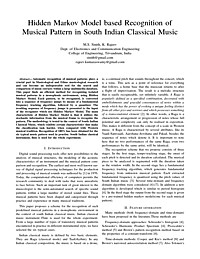
Hidden Markov Model based recognition of musical pattern in South Indian Classical Music
Automatic recognition of musical patterns plays a crucial part in Musicological and Ethno musicological research and can become an indispensable tool for the search and comparison of music extracts within a large multimedia database. This paper finds an efficient method for recognizing isolated musical patterns in a monophonic environment, using Hidden Markov Model. Each pattern, to be recognized, is converted into a sequence of frequency jumps by means of a fundamental frequency tracking algorithm, followed by a quantizer. The resulting sequence of frequency jumps is presented to the input of the recognizer which use Hidden Markov Model. The main characteristic of Hidden Markov Model is that it utilizes the stochastic information from the musical frame to recognize the pattern. The methodology is tested in the context of South Indian Classical Music, which exhibits certain characteristics that make the classification task harder, when compared with Western musical tradition. Recognition of 100% has been obtained for the six typical music pattern used in practise. South Indian classical instrument, flute is used for the whole experiment.
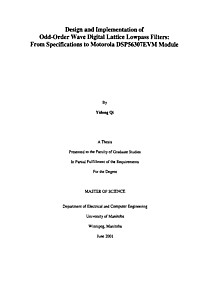
Design and implementation of odd-order wave digital lattice lowpass filters, from specifications to Motorol DSP56307EVM module
This thesis is dedicated to applying and developing explicit formulas for the design and implementation of odd-order lattice Lowpass wave digital filters (WDFs) on a Digital Signal Processor (DSP), such as a Motorola DSP56307EVM (Evaluation Module). The direct design method of Gazsi for filter types such as Butterworfh, Chebyshev, inverse Chebyshev, and Cauer (Elliptic) provides a straightforward method for calculating the coefficients without an extensive knowledge of digital signal processing. A program package to design and implement odd-order WDFs, including detailed procedures and examples, is presented in this thesis and includes not only the calculations of the coefficients, but also the simulation on a MATLAB platform and an implementation on a Motorola DSP56307EVM board. It is very quick, effective and convenient to obtain the coefficients when the user enters a few parameters according to the general specifications; to verify the characteristics of the designed filter; to simulate the filter on the MATLAB platform; to implement the filter on the DSP board; and to compare the results between the simulation and the implementation.
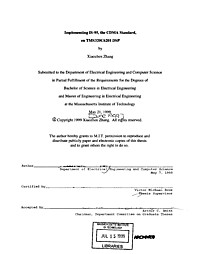
Implementing IS-95, the CDMA Standard, on TMS320C6201 DSP
IS-95 is the present U.S. 2nd generation CDMA standard. Currently, the 2nd generation CDMA phones are produced by Qualcomm. Texas Instruments (TI) has ASIC design for Viterbi Decoder on C54x. Several of the components in the forward link process are also implemented in hardware. However, having to design a specific hardware for a particular application is expensive and time consuming. Thus, the possibility of the alternative implementations is of great interest to both customers and TI itself. This research has achieved in successful implementation of IS-95 entirely in software on TI fixed-point DSP TMS320C6201, and met the real time constraint. IS-95 system, the industrial standard for CDMA, is a very complicated system and extremely computationally demanding. The transmission rate for an IS-95 system is 1.2288 Mcps. This research project includes all the major components of the demodulation process for the forward link system: PN Descrambling, Walsh Despreading, Phase Correction & Maximal Ratio Combining, Deinterleaver, Digital Automatic Gain Control, and Viterbi Deccc:r. The entire demodulation process is done completely in C. That makes it a very attractive alternative implementation in the future applications. It is well known that ASIC design is not only expensive and but also time consuming, programming in assembly is easier and cheaper, but programming in C is a much easier and efficient way out, in particular, for general computer engineers. During the whole process, efforts have been devoted on developing various specific techniques to optimize the design for all the components involved. These developments are successfully achieved by making the best use of the following techniques: to simplify the algorithms first before programming, to look for regularity in the problem, to work toward the Compiler's full efficiency, and to use C intrinsics whenever possible. All these attributes together make the implementation scheme great for DSP applications. The benchmark results compare very well to the TI-internal hand scheduled assembly performance of the same type of decoders. The estimated percentage usage of all the components (excluding PN) is only 21.18% of the total CPU cycles available (4,000 K), which is very efficient and impressive.
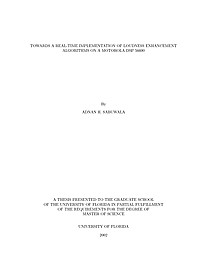
Towards a Real-Time Implementation of Loudness Enhancement Algorithms on a Motorola DSP 56600
Most of the cellular phone companies with audio speaker capabilities focus on reducing the current drain to extend battery life. None of these companies concentrate on modifying the speech signal itself to make it sound louder in noisy listener environments without adding additional energy. Such algorithms have been described in literature by Boillot and form the backbone of this thesis. The current project focusses on taking a step towards running these algorithms in real-time on a 16-bit fixed point Motorola DSP 56600. Implementation of the autocorrelation, Levinson- Durbin, FIR, and IIR filters in assembly for the Motorola DSP 56600 has been investigated in the thesis. The challenges and alternate solutions to circumvent the challenges have been described, and experimental results have been presented. Results indicate that the modified signed LMS algorithm, which can be considered to be a blend between the LMS and signed LMS algorithms, turns out to be an elegant solution to circumvent the challenges in implementing the Levinson-Durbin recursion.
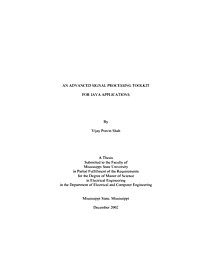
An Advanced Signal Processing Toolkit for Java applications
The aim of this study is to examine the capability, performance, and relevance of a signal processing toolkit in Java, a programming language for Web-based applications. Due to the simplicity, ease and application use of the toolkit and with the advanced Internet technologies such as Remote Method Invocation (RMI), a spectral estimation applet has been created in the Java environment. This toolkit also provides an interactive and visual approach in understanding the various theoretical concepts of spectral estimation and shows the need to create more application applets to better understand the various concepts of signal and image processing. This study also focuses on creating a Java toolkit for embedded systems, such as Personal Digital Assistants (PDAs), embedded Java board, and supporting integer precision, and utilizing COordinate Rotation DIgital Computer (CORDIC) algorithm, both aimed to provide good performance in resource-limited environments. The results show a feasibility and necessity of developing a standardized Application Programming Interface (API) for the fixed-point signal processing library.
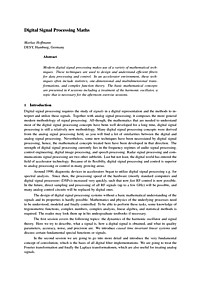
Digital Signal Processing Maths
Modern digital signal processing makes use of a variety of mathematical techniques. These techniques are used to design and understand efficient filters for data processing and control.
Signal Processing Requirements for WiMAX (802.16e) Base Station
802.16e provides specifications for non line of sight, mobile wireless communications in the frequency range of 2-6 GHz. It is well implemented by using OFDMA as its physical layer scheme. The OFDM symbol time (sT) is to be selected depending on the channel conditions, available bandwidth and, simulations provide a means of selecting right values of sTin different channel conditions. Additionally it has been shown that certain values of sT outperform others in all conditions, thus invalidating their use. Moreover, a solution proposed by INTEL is also analyzed. One of the major requirements of OFDM is high synchronization. Detecting the timing offset of a new mobile user, entering the network, which is not time aligned using cross-correlation and ‘auto-correlation’ in time domain and cross-correlation in frequency domain at the base station has been simulated. Results point that the processing load can be significantly reduced by using frequency domain correlation of the received data or by using ‘auto-correlation’ followed by cross-correlation on localized data. The use of adaptive antenna system in 802.16e improves the system performance, where beamforming is implemented in the direction of desired user. Capon’s method and MUSIC method have been simulated to compute the direction of arrival for OFDMA uplink. A new user, while in the ranging process, transmits data with unknown time offset and unknown direction. The thesis describes the procedure to find the two unknown one after another.
An FPGA Implementation of Hierarchical Motion Estimation for Embedded Oject Tracking
This paper presents the hardware implementation of an algorithm developed to provide automatic motion detection and object tracking functionality embedded within intelligent CCTV systems. The implementation is targeted at an Altera Stratix FPGA making full use of the dedicated DSP resource. The Altera Nios embedded processor provides a platform for the tracking control loop and generic Pan Tilt Zoom camera interface. This paper details the explicit functional stages of the algorithm that lend themselves to an optimised pipelined hardware implementation. This implementation provides maximum data throughput, providing real-time operation of the described algorithm, and enables a moving camera to track a moving object in real time.
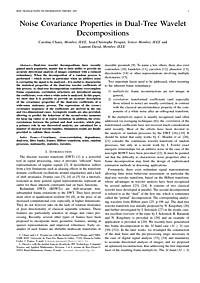
Noise covariance properties in Dual-Tree Wavelet Decompositions
Dual-tree wavelet decompositions have recently gained much popularity, mainly due to their ability to provide an accurate directional analysis of images combined with a reduced redundancy. When the decomposition of a random process is performed – which occurs in particular when an additive noise is corrupting the signal to be analyzed – it is useful to characterize the statistical properties of the dual-tree wavelet coefficients of this process. As dual-tree decompositions constitute overcomplete frame expansions, correlation structures are introduced among the coefficients, even when a white noise is analyzed. In this paper, we show that it is possible to provide an accurate description of the covariance properties of the dual-tree coefficients of a wide-sense stationary process. The expressions of the (cross-) covariance sequences of the coefficients are derived in the one and two-dimensional cases. Asymptotic results are also provided, allowing to predict the behaviour of the second-order moments for large lag values or at coarse resolution. In addition, the crosscorrelations between the primal and dual wavelets, which play a primary role in our theoretical analysis, are calculated for a number of classical wavelet families. Simulation results are finally provided to validate these results.
Code Acquisition using Smart Antennas with Adaptive Filtering Scheme for DS-CDMA Systems
Pseudo-noise (PN) code synchronizer is an essential element of direct-sequence code division multiple access (DS-CDMA) system because data transmission is possible only after the receiver accurately synchronizes the locally generated PN code with the incoming PN code. The code synchronization is processed in two steps, acquisition and tracking, to estimate the delay offset between the two codes. Recently, the adaptive LMS filtering scheme has been proposed for performing both code acquisition and tracking with the identical structure, where the LMS algorithm is used to adjust the FIR filter taps to search for the value of delay-offset adaptively. A decision device is employed in the adaptive LMS filtering scheme as a decision variable to indicate code synchronization, hence it plays an important role for the performance of mean acquisition time (MAT). In this thesis, only code acquisition is considered. In this thesis, a new decision device, referred to as the weight vector square norm (WVSN) test method, is devised associated with the adaptive LMS filtering scheme for code acquisition in DS-CDMA system. The system probabilities of the proposed scheme are derived for evaluating MAT. Numerical analyses and simulation results verify that the performance of the proposed scheme, in terms of detection probability and MAT, is superior to the conventional scheme with mean-squared error (MSE) test method, especially when the signal-to-interference-plus-noise ratio (SINR) is relatively low. Furthermore, an efficient and joint-adaptation code acquisition scheme, i.e., a smart antenna coupled with the proposed adaptive LMS filtering scheme with the WVSN test method, is devised for applying to a base station, where all antenna elements are employed during PN code acquisition. This new scheme is a process of PN code acquisition and the weight coefficients of smart antenna jointly and adaptively. Numerical analyses and simulation results demonstrate that the performance of the proposed scheme with five antenna elements, in terms of the output SINR, the detection probability and the MAT, can be improved by around 7 dB, compared to the one with single antenna case.
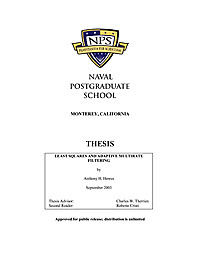
Least Squares and Adaptive Multirate Filtering
This thesis addresses the problem of estimating a random process from two observed signals sampled at different rates. The case where the low–rate observation has a higher signal–to– noise ratio than the high–rate observation is addressed. Both adaptive and non–adaptive filtering techniques are explored. For the non–adaptive case, a multirate version of the Wiener–Hopf optimal filter is used for estimation. Three forms of the filter are described. It is shown that using both observations with this filter achieves a lower mean–squared error than using either sequence alone. Furthermore, the amount of training data to solve for the filter weights is comparable to that needed when using either sequence alone. For the adaptive case, a multirate version of the LMS adaptive algorithm is developed. Both narrowband and broadband interference are removed using the algorithm in an adaptive noise cancellation scheme. The ability to remove interference at the high rate using observations taken at the low rate without the high–rate observations is demonstrated.
Energy Profiling of DSP Applications, A Case Study of an Intelligent ECG Monitor
Proper balance of power and performance for optimum system organization requires precise profiling of the power consumption of different hardware subsystems as well as software functions. Moreover, power consumption of mobile systems is even more important, since the battery is a large portion of the overall size and weight of the system. Average power consumption is only a crude estimate of power requirements and battery life; a much better estimate can be made using dynamic power consumption. Dynamic power consumption is a function of the execution profile of the given application running on specific hardware platform. In this paper we introduce a new environment for energy profiling of DSP applications. The environment consists of a JTAG emulator, a high-resolution HP 3583A multimeter and a workstation that controls devices and stores the traces. We use Texas Instruments’ Real Time Data Exchange mechanism (RTDXÔ) to generate an execution profile and custom procedures for energy profile data acquisition using GPIB interface. We developed custom procedures to correlate and analyze both energy and execution profiles. The environment allows us to improve the system power consumption through changes in software organization and to measure real battery life for the given hardware, software and battery configuration. As a case study, we present the analysis of a real-time portable ECG monitor implemented using a Texas Instruments TMS320C5410-100 processor board, and a Del Mar PWA ECG Amplifier.
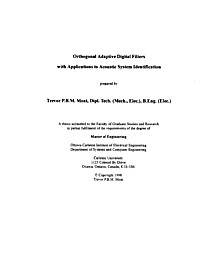
Orthogonal Adaptive Digital Filters with Applications to Acoustic System Identification
The Transform-Domain LMS Algorithm (Narayan, 1983) is studied in the context of an acoustic system identification problem. The power estimator in this two-stage digital filter is shown to affect the achievable rates and depths of convergence significantly. Preferred values for the two tracking parameters, $\beta$ and $\mu,$ are determined. Dynamic Step-size Initialization is proposed to improve early convergence by accelerating the rate at which true power measurements replace (arbitrary) initial values. Later, linear estimators are shown to be sub-optimal, particularly where the spectral distribution of the reference changes rapidly. A simple non-linear Peak Window Power Estimator which eliminates these problems is described. It will be shown to improve the tracking rates and misadjustment simultaneously. The benefits of these methods are demonstrated using FIR sequences representative of typical acoustic environments and using recordings from a commercial telephone set. The proposed structures surpass theexisting algorithms consistently under all circumstances tested.
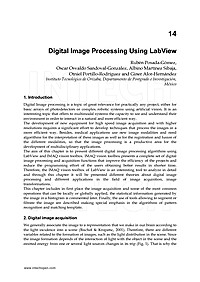
Digital Image Processing Using LabView
Digital Image processing is a topic of great relevance for practically any project, either for basic arrays of photodetectors or complex robotic systems using artificial vision. It is an interesting topic that offers to multimodal systems the capacity to see and understand their environment in order to interact in a natural and more efficient way. The development of new equipment for high speed image acquisition and with higher resolutions requires a significant effort to develop techniques that process the images in a more efficient way. Besides, medical applications use new image modalities and need algorithms for the interpretation of these images as well as for the registration and fusion of the different modalities, so that the image processing is a productive area for the development of multidisciplinary applications. The aim of this chapter is to present different digital image processing algorithms using LabView and IMAQ vision toolbox. IMAQ vision toolbox presents a complete set of digital image processing and acquisition functions that improve the efficiency of the projects and reduce the programming effort of the users obtaining better results in shorter time. Therefore, the IMAQ vision toolbox of LabView is an interesting tool to analyze in detail and through this chapter it will be presented different theories about digital image processing and different applications in the field of image acquisition, image transformations. This chapter includes in first place the image acquisition and some of the most common operations that can be locally or globally applied, the statistical information generated by the image in a histogram is commented later. Finally, the use of tools allowing to segment or filtrate the image are described making special emphasis in the algorithms of pattern recognition and matching template.
A pole-zero placement technique for designing second-order IIR parametric equalizer filters
A new procedure is presented for designing second-order parametric equalizer filters. In contrast to the traditional approach, in which the design is based on a bilinear transform of an analog filter, the presented procedure allows for designing the filter directly in the digital domain. A rather intuitive technique known as pole-zero placement, is treated here in a quantitative way. It is shown that by making some meaningful approximations, a set of relatively simple design equations can be obtained. Design examples of both notch and resonance filters are included to illustrate the performance of the proposed method, and to compare with state-of-the-art solutions.



















